Co-Extrusion of Dissimilar Aluminum Alloys via Shear-Assisted Processing and Extrusion
Abstract
:1. Introduction
2. Experimental Methods
3. SPH Modeling
4. Results and Discussion
4.1. Process Data
4.2. Microstructural Characterization
4.3. Mechanical Property Characterization
4.4. Material Flow Analysis during Co-Extrusion via ShAPE
5. Summary
- The co-extruded tubes exhibited defect-free surfaces and cross sections under all four extrusion conditions. The processes were in steady state for more than 87% of the extrusion length, which demonstrates the stability of the co-extrusion process. Furthermore, the designed core-to-cladding ratio was realized in all four cladded tubes, which shows the robustness of co-extrusion despite having a rotating extrusion die.
- The interface between 6061 and 7075 was metallurgically bonded in all the extrudates; more importantly, the extrudates exhibited defect-free interfacial regions. Obtaining a defect-free tube is a first step toward fabricating cladded tubes that have structural integrity. The cladded extrudates exhibited a strong work-hardening regime, which indicates the ability of these tubes to sustain significant loads before failure. An optimized heat treatment of 105 °C for 6 h + 175 °C for 8 h was found to lead to increased hardness and tensile strength due to age hardening of the 6061 and 7075 alloy regions.
- Material flow analysis based on the SPH model revealed that the cladding material travels a longer distance than the core material before being extruded. Furthermore, no material mixing other than the metallurgically bonded interface across the core and cladding was noted in both experiments and SPH modeling.
Author Contributions
Funding
Institutional Review Board Statement
Informed Consent Statement
Data Availability Statement
Acknowledgments
Conflicts of Interest
References
- Pantelakis, S.G.; Chamos, A.; Kermanidis, A.T. A critical consideration for the use of Al-cladding for protecting aircraft aluminum alloy 2024 against corrosion. Theor. Appl. Fract. Mech. 2012, 57, 36–42. [Google Scholar] [CrossRef]
- Martínez-Viademonte, M.P.; Abrahami, S.T.; Hack, T.; Burchardt, M.; Terryn, H. A review on anodizing of aerospace aluminum alloys for corrosion protection. Coatings 2020, 10, 1106. [Google Scholar] [CrossRef]
- Latham, E.P.; Meadowcroft, D.B.; Pinder, L. Coextrusion cladding for oxidation protection. Mater. Sci. Technol. 1989, 5, 813–815. [Google Scholar] [CrossRef]
- Tang, J.; Chen, L.; Fan, X.; Zhao, G.; Zhang, C. Co-extrusion of dissimilar AA6063/AA7075 by porthole die at various temperatures. J. Alloys Compd. 2018, 764, 162–169. [Google Scholar] [CrossRef]
- Kuhnke, S.; Sanabria, V.; Gensch, F.; Nitschke, R.; Mueller, S. Numerical Investigations on material flow during indirect extrusion of copper-clad aluminum rods. Front. Mater. 2020, 7, 157. [Google Scholar] [CrossRef]
- Feng, B.; Sun, Z.; Wu, Y.; Feng, X.; Wang, J.; Zheng, K. Microstructure and mechanical behavior of Mg ZK60/Al 1100 composite plates fabricated by co-extrusion. J. Alloys Compd. 2020, 842, 155676. [Google Scholar] [CrossRef]
- Chen, H.; Giannopoulou, D.; Greß, T.; Isakovic, J.; Mittler, T.; Volk, W.; Khalifa, N.B. Homogenization of the interfacial bonding of compound-cast AA7075/6060 bilayer billets by co-extrusion. Int. J. Mater. Form. 2021, 14, 1109–1119. [Google Scholar] [CrossRef]
- Greß, T.; Mittler, T.; Chen, H.; Stahl, J.; Schmid, S.; Khalifa, N.B.; Volk, W. Production of aluminum AA7075/6060 compounds by die casting and hot extrusion. J. Mater. Process. Technol. 2020, 280, 116594. [Google Scholar] [CrossRef]
- Jha, S.; Dixit, S.; Chetan, K.; Vaibhaw, K.; Srivastava, D. Co-extrusion of Zircaloy-2 and Zr-Sn alloy for double clad tube manufacturing: Numerical simulation and experimental validation. J. Manuf. Process. 2019, 39, 18–25. [Google Scholar] [CrossRef]
- Lavender, C.A.; Joshi, V.V.; Grant, G.J.; Jana, S.; Whalen, S.A.; Darsell, J.T.; Overman, N.R. System and Process for Formation of Extrusion Products; Pacific Northwest National Lab (PNNL): Richland, WA, USA, 2019.
- Whalen, S.; Olszta, M.; Reza-E-Rabby, M.; Roosendaal, T.; Wang, T.; Herling, D.; Taysom, B.S.; Suffield, S.; Overman, N. High speed manufacturing of aluminum alloy 7075 tubing by Shear Assisted Processing and Extrusion (ShAPE). J. Manuf. Process. 2021, 71, 699–710. [Google Scholar] [CrossRef]
- Komarasamy, M.; Whalen, S.; Taysom, B.; Herling, D. Co-Extrusion of Dissimilar Al Alloys via Shear Assisted Processing and Extrusion. In Light Metals 2022; Springer: Cham, Switzerland, 2022; pp. 308–313. [Google Scholar]
- Anderson, K.; Kaufman, J.G.; Weritz, J. ASM Handbook: Volume 2B Properties and Selection of Aluminum Alloys; ASM International: Materials Park, OH, USA, 2019. [Google Scholar]
- ASTM-B557; Standard Test Methods for Tension Testing Wrought and Cast Aluminum- and Magnesium-Alloy Products. ASTM: West Conshohocken, PA, USA, 2015.
- Lucy, L.B. A numerical approach to the testing of the fission hypothesis. Astron. J. 1977, 82, 1013–1024. [Google Scholar] [CrossRef]
- Gingold, R.A.; Monaghan, J.J. Smoothed particle hydrodynamics: Theory and application to non-spherical stars. Mon. Not. R. Astron. Soc. 1977, 181, 375–389. [Google Scholar] [CrossRef]
- Liu, M.; Liu, G. Smoothed particle hydrodynamics (SPH): An overview and recent developments. Arch. Comput. Methods Eng. 2010, 17, 25–76. [Google Scholar] [CrossRef]
- Li, L.; Gupta, V.; Li, X.; Reynolds, A.P.; Grant, G.; Soulami, A. Meshfree simulation and experimental validation of extreme thermomechanical conditions in friction stir extrusion. Comput. Part. Mech. 2022, 9, 789–809. [Google Scholar] [CrossRef]
- Li, L.; Reza-E-Rabby, M.; Overman, N.; Wang, T.; Whalen, S.; Grant, G.; Mathaudhu, S.; Soulami, A. Analysis of contact conditions and microstructure evolution in shear assisted processing and extrusion using smoothed particle hydrodynamics method. Mater. Des. 2022, 221, 111010. [Google Scholar] [CrossRef]
- Johnson, G.R.; Cook, W.H. Fracture characteristics of three metals subjected to various strains, strain rates, temperatures and pressures. Eng. Fract. Mech. 1985, 21, 31–48. [Google Scholar] [CrossRef]
- Lesuer, D.R.; Kay, G.; LeBlanc, M. Modeling Large-Strain, High-Rate Deformation in Metals; Lawrence Livermore National Lab (LLNL): Livermore, CA, USA, 2001.
- Brar, N.; Joshi, V.; Harris, B. Constitutive model constants for Al7075-t651 and Al7075-t6. AIP Conf. Proc. 2009, 1195, 945–948. [Google Scholar]
- Zhang, H.; Zhao, X.; Deng, X.; Sutton, M.A.; Reynolds, A.P.; McNeill, S.R.; Ke, X. Investigation of material flow during friction extrusion process. Int. J. Mech. Sci. 2014, 85, 130–141. [Google Scholar] [CrossRef]
- Khosravifard, A.; Ebrahimi, R. Investigation of parameters affecting interface strength in Al/Cu clad bimetal rod extrusion process. Mater. Des. 2010, 31, 493–499. [Google Scholar] [CrossRef]
- Ivanisenko, Y.; Kulagin, R.; Fedorov, V.; Mazilkin, A.; Scherer, T.; Baretzky, B.; Hahn, H. High pressure torsion extrusion as a new severe plastic deformation process. Mater. Sci. Eng. A 2016, 664, 247–256. [Google Scholar] [CrossRef]
- Zhilyaev, A.P.; Langdon, T.G. Using high-pressure torsion for metal processing: Fundamentals and applications. Prog. Mater. Sci. 2008, 53, 893–979. [Google Scholar] [CrossRef]
- Qian, L.; Cui, Z.; Sun, C.; Geng, S.; Sun, Z. Investigation of deformation compatibility and power consumption during KOBO extrusion of bimetallic composite tube. Int. J. Adv. Manuf. Technol. 2022, 118, 3477–3486. [Google Scholar] [CrossRef]
- Mohotti, D.; Ngo, T.; Raman, S.N.; Ali, M.; Mendis, P. Plastic deformation of polyurea coated composite aluminium plates subjected to low velocity impact. Mater. Des. (1980–2015) 2014, 56, 696–713. [Google Scholar] [CrossRef]
- Bochniak, W.; Marszowski, K.; Korbel, A. Theoretical and practical aspects of the production of thin-walled tubes by the KOBO method. J. Mater. Process. Technol. 2005, 169, 44–53. [Google Scholar] [CrossRef]
- Srivastava, A.; Vaughan, M.W.; Mansoor, B.; Nasim, W.; Barber, R.E.; Karaman, I.; Hartwig, K.T. Tube equal channel angular extrusion (tECAE) of Mg–3Al–1Zn alloy. Mater. Sci. Eng. A 2021, 814, 141236. [Google Scholar] [CrossRef]
- Ebrahimi, M.; Shaeri, M.; Naseri, R.; Gode, C. Equal channel angular extrusion for tube configuration of Al-Zn-Mg-Cu alloy. Mater. Sci. Eng. A 2018, 731, 569–576. [Google Scholar] [CrossRef]
- Shunmugasamy, V.C.; Khalid, E.; Mansoor, B. Friction stir extrusion of ultra-thin wall biodegradable magnesium alloy tubes—Microstructure and corrosion response. Mater. Today Commun. 2021, 26, 102129. [Google Scholar] [CrossRef]
- Abu-Farha, F. A preliminary study on the feasibility of friction stir back extrusion. Scr. Mater. 2012, 66, 615–618. [Google Scholar] [CrossRef]
- Thürer, S.; Uhe, J.; Golovko, O.; Bonk, C.; Bouguecha, A.; Klose, C.; Behrens, B.-A.; Maier, H. Co-extrusion of semi-finished aluminium-steel compounds. AIP Conf. Proc. 2017, 1896, 140002. [Google Scholar]
- Thürer, S.E.; Peddinghaus, J.; Heimes, N.; Bayram, F.C.; Bal, B.; Uhe, J.; Behrens, B.-A.; Maier, H.J.; Klose, C. Lateral angular co-extrusion: Geometrical and mechanical properties of compound profiles. Metals 2020, 10, 1162. [Google Scholar] [CrossRef]



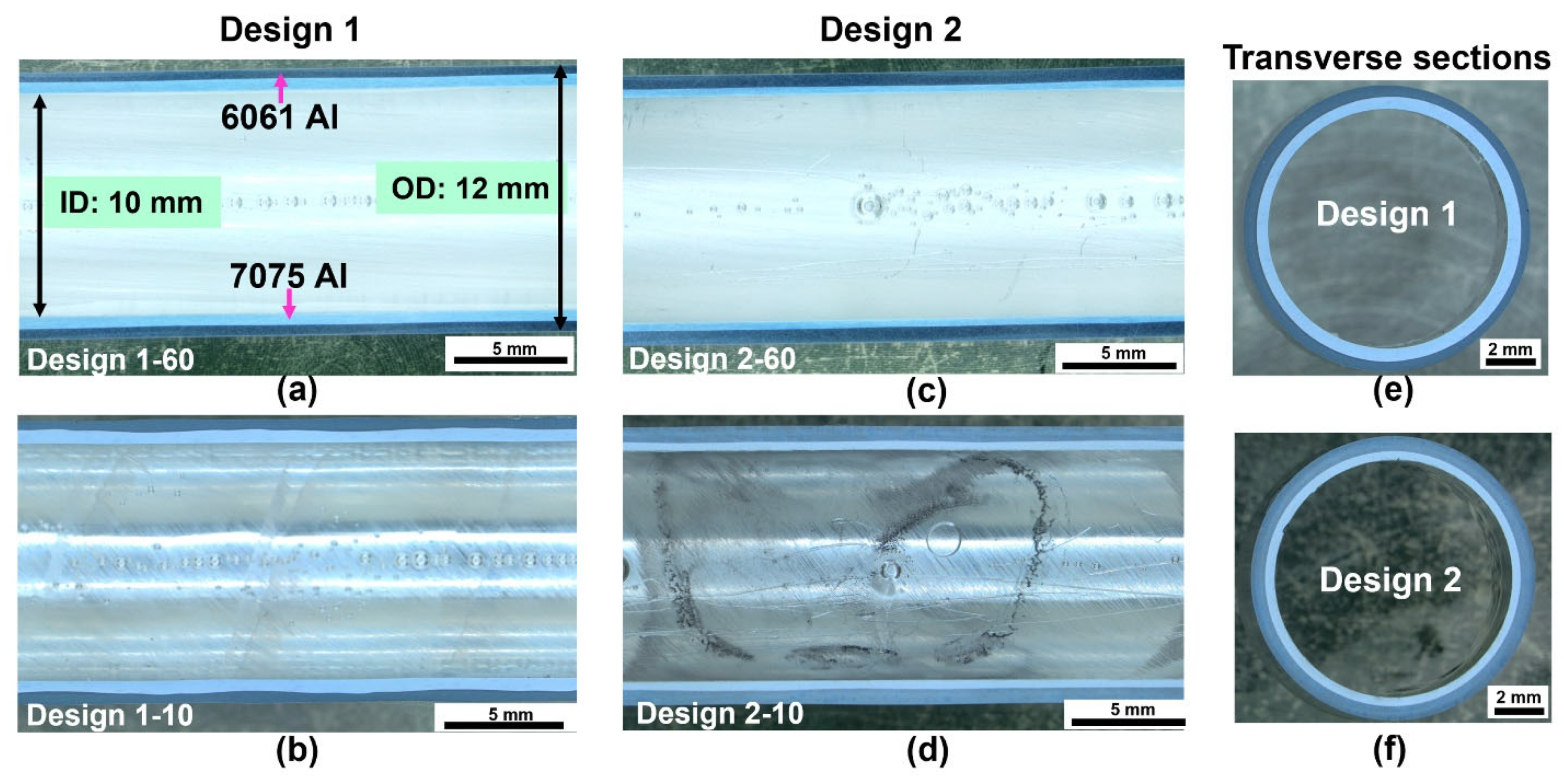

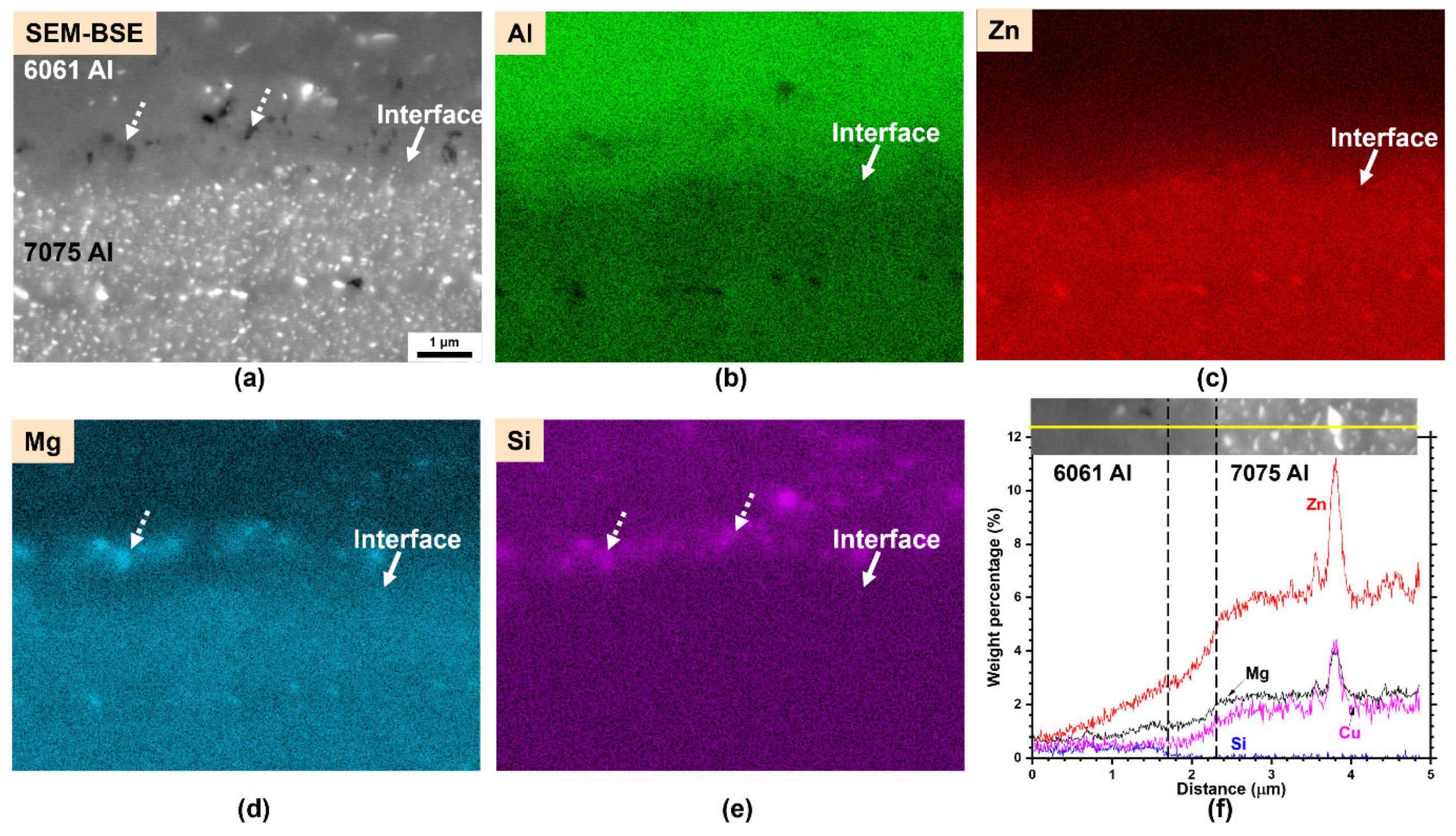
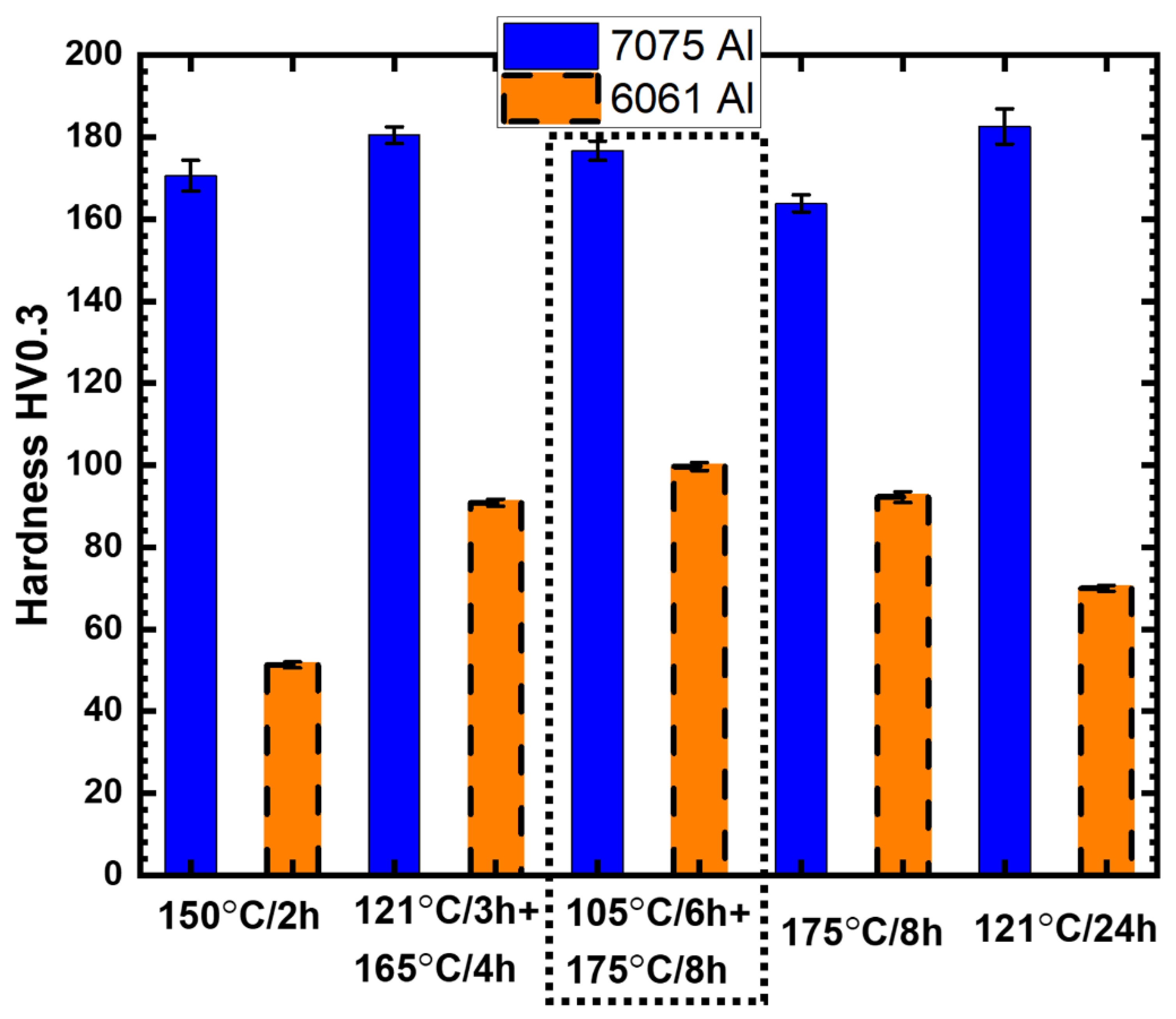

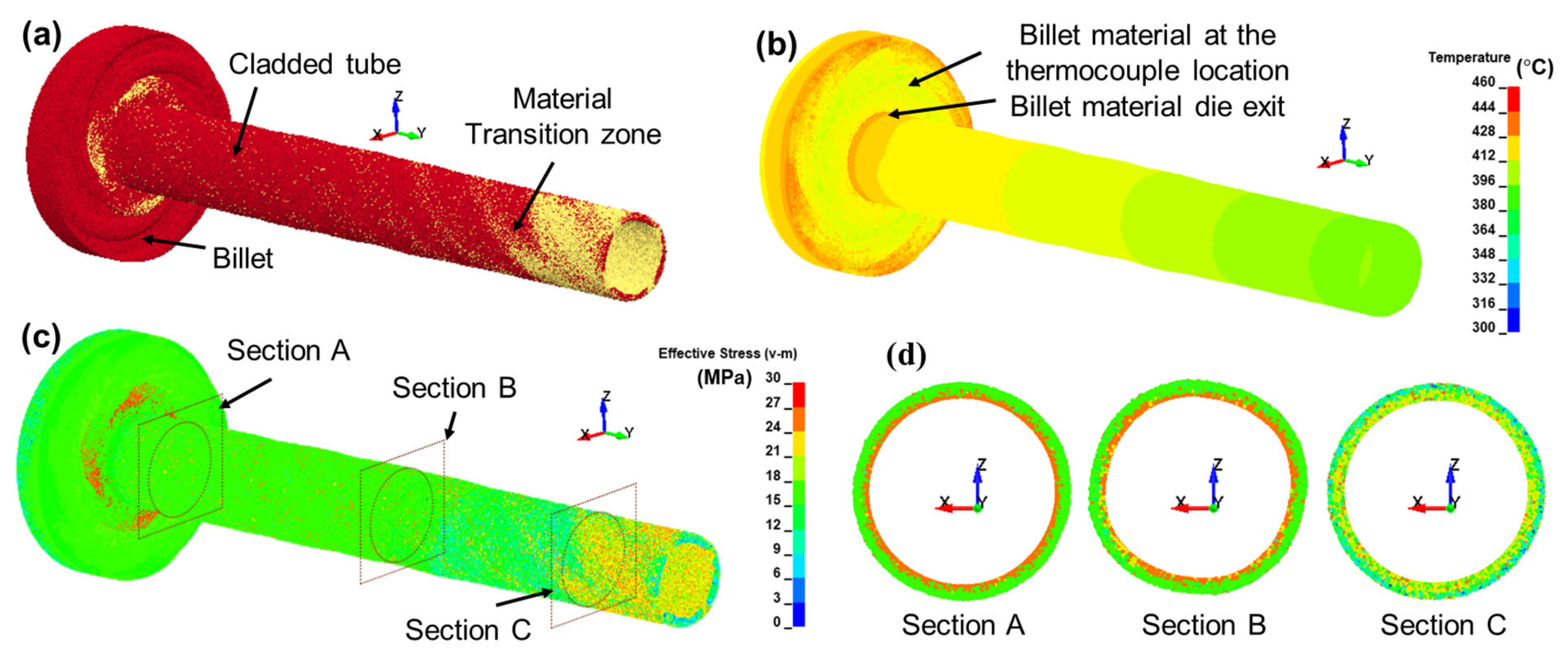

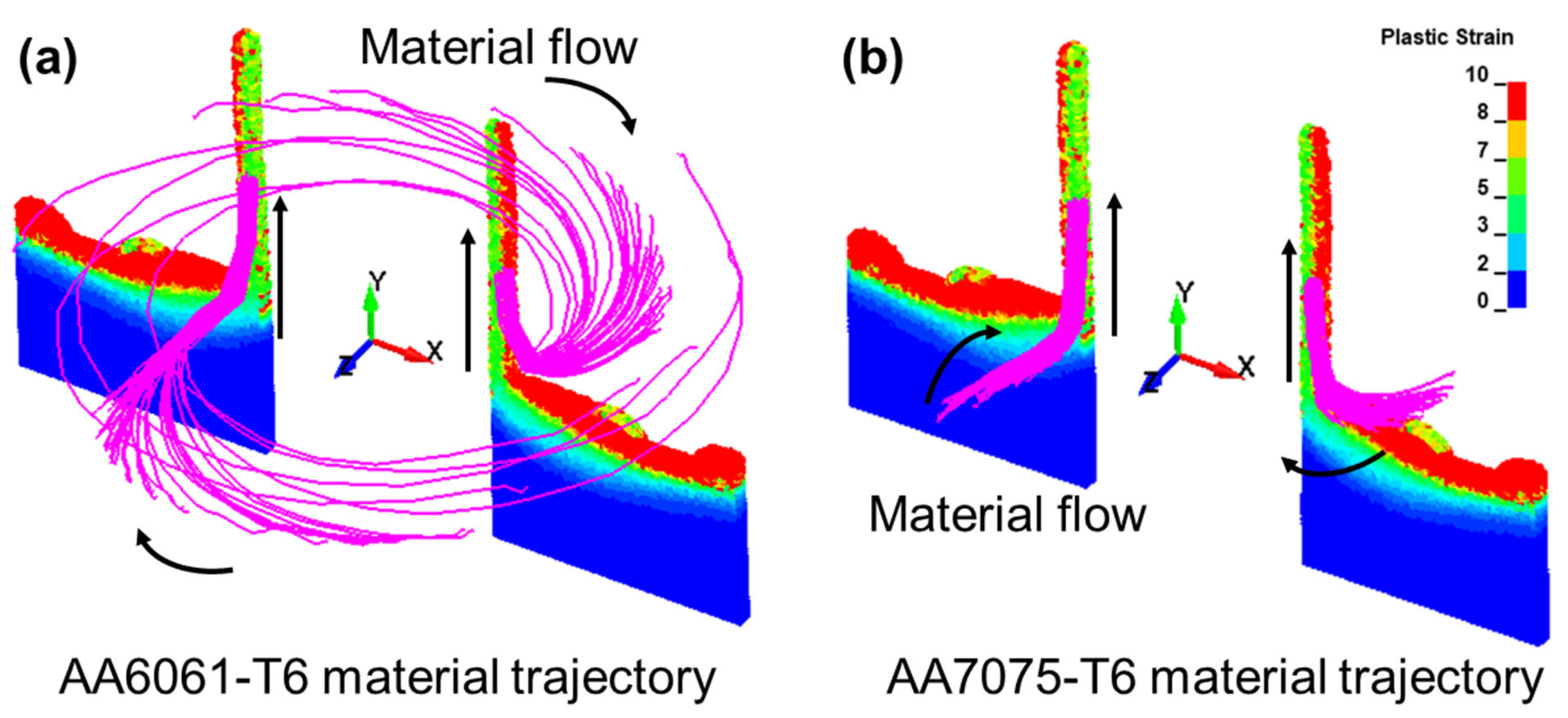
| Material Combination | Feed Rate (mm/min) | Die Rotational Speed (RPM) | Tube Length (mm) |
|---|---|---|---|
| Design 1–60 | 60 | 27 | 1956 |
| Design 2–60 | 27 | 1981 | |
| Design 1–10 | 10 | 30 | 1803 |
| Design 2–10 | 27 | 1820 |
| Parameter | Description | Unit | 6061-T6 | 7075-T6 |
|---|---|---|---|---|
| Values | ||||
| J-C material model parameter | MPa | 36.86 | 51.69 | |
| MPa | 0 | 0 | ||
| - | 0 | 0 | ||
| - | 0.002 | 0.024 | ||
| - | 1.34 | 1.56 | ||
| 24 | 24 | |||
| 640 | 628 | |||
| 1 | 1 | |||
| Density | g/cm3 | 2.7 | 2.81 | |
| Young’s modulus | GPa | 48 | 31.5 | |
| Poisson’s ratio | - | 0.33 | 0.33 | |
| Heat capacity | J/g·°C | 1.11 | 1.28 | |
| Thermal conductivity | W/m·°C | 181 | 168 | |
| Material Combination | Average Thickness (mm) | |
|---|---|---|
| Core | Cladding | |
| Design 1–60 | 0.5 ± 0.02 | 0.45 ± 0.04 |
| Design 1–10 | 0.54 ± 0.07 | 0.47 ± 0.1 |
| Design 2–60 | 0.34 ± 0.03 | 0.62 ± 0.03 |
| Design 2–10 | 0.38 ± 0.03 | 0.65 ± 0.05 |
| Material Combination | YS (MPa) | UTS (MPa) | Total Elongation |
|---|---|---|---|
| As-extruded | |||
| Design 1–60 | 180 ± 2 | 254 ± 2 | 12.4 ± 0.1 |
| Design 1–10 | 218 ± 3 | 349 ± 3 | 18.0 ± 1.0 |
| Design 2–60 | 167 ± 2 | 223 ± 1.0 | 7.0 ± 1.0 |
| Design 2–10 | 145 ± 1 | 241 ± 0 | 7.1 ± 0.1 |
| Solution heat treated and aged | |||
| Design 1–60 | 270 ± 0 | 339 ± 2 | 5.4 ± 1.5 |
| Design 1–10 | 281 ± 2 | 347 ± 5 | 2.8 ± 0.1 |
| Design 2–60 | 208 ± 0 | 270 ± 3 | 2.5 ± 0.1 |
| Design 2–10 | 202 ± 4 | 272 ± 9 | 4.7 ± 1.0 |
Disclaimer/Publisher’s Note: The statements, opinions and data contained in all publications are solely those of the individual author(s) and contributor(s) and not of MDPI and/or the editor(s). MDPI and/or the editor(s) disclaim responsibility for any injury to people or property resulting from any ideas, methods, instructions or products referred to in the content. |
© 2023 by the authors. Licensee MDPI, Basel, Switzerland. This article is an open access article distributed under the terms and conditions of the Creative Commons Attribution (CC BY) license (https://creativecommons.org/licenses/by/4.0/).
Share and Cite
Komarasamy, M.; Li, L.; Taysom, B.; Soulami, A.; Grant, G.; Herling, D.; Whalen, S. Co-Extrusion of Dissimilar Aluminum Alloys via Shear-Assisted Processing and Extrusion. Coatings 2024, 14, 42. https://doi.org/10.3390/coatings14010042
Komarasamy M, Li L, Taysom B, Soulami A, Grant G, Herling D, Whalen S. Co-Extrusion of Dissimilar Aluminum Alloys via Shear-Assisted Processing and Extrusion. Coatings. 2024; 14(1):42. https://doi.org/10.3390/coatings14010042
Chicago/Turabian StyleKomarasamy, Mageshwari, Lei Li, Brandon Taysom, Ayoub Soulami, Glenn Grant, Darrell Herling, and Scott Whalen. 2024. "Co-Extrusion of Dissimilar Aluminum Alloys via Shear-Assisted Processing and Extrusion" Coatings 14, no. 1: 42. https://doi.org/10.3390/coatings14010042
APA StyleKomarasamy, M., Li, L., Taysom, B., Soulami, A., Grant, G., Herling, D., & Whalen, S. (2024). Co-Extrusion of Dissimilar Aluminum Alloys via Shear-Assisted Processing and Extrusion. Coatings, 14(1), 42. https://doi.org/10.3390/coatings14010042







